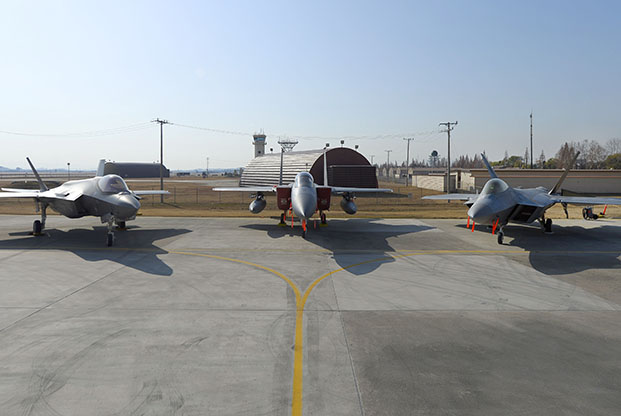The Air Force next month will roll out two initial batches of technology intended to help the F-22 and F-35 “talk,” and to provide a fuller picture of US combat assets in a particular area.
Starting in December, the service plans to demonstrate a new way of getting its two most advanced fighter jets to communicate using the first iteration of a secure, encrypted data link. Officials hope to introduce upgrades every four months, according to Preston Dunlap, the Air Force’s chief architect for the Advanced Battle Management System.
The data link will translate the information one platform sends—like location, targeting, and more—into a format the other can process, Dunlap said at a Nov. 7 conference hosted by Defense One. Over time, the Air Force hopes to introduce a new system that lets the planes talk more directly.
Getting the F-35 and F-22 to share data, and broadening the effort’s scope to help the other military services transmit information more easily, play into the Defense Department’s vision of more interconnected combat operations, which the Air Force is pursuing under ABMS.
At the same time, the Air Force plans to debut an early version of “Omnia One,” an app that intends to show a common operating picture of combat assets across air, land, sea, space, and cyberspace. Right now, its situational awareness is largely limited to air assets.
The idea is to pattern such an app after something like Uber or FlightAware, where “you can see a picture, you can click on the ship, [and see] where it’s been, where it’s traveling, what’s on the ship. … We need to be able to get that to our warfighters in a way that’s accessible,” Dunlap said.
Thinking about these kinds of apps is still in its infancy, as the Air Force is focused on building what it calls the “highway,” or a network that enables these technologies to work together. But some are starting to consider how different generations of service members process information, and how that could shape what people see on their screens.
“What type of information do I need to actually make a decision?” said Brig Gen. David Kumashiro, joint force integration director under the Air Force’s deputy chief of staff for strategy, integration, and requirements. “A baby boomer might make a decision in a much different manner, might accept and absorb information in a much different manner than I, as someone from Gen X. Compare that, then, to the millennial generation and Gen Z.”
Older airmen might be able to handle multiple Microsoft and chat windows open at once, while younger airmen could be comfortable with elements like virtual reality in their workspaces, he said.
“How do you create that system that’s actually intuitive, that recognizes the user,” Kumashiro added. “We’re definitely thinking about that.”
The technology in development could eventually help service members do their jobs from anywhere, not just a brick-and-mortar facility like the Combined Air Operations Center that manages air tasking from Al Udeid AB, Qatar.
Kumashiro told Air Force Magazine he expects the service’s burgeoning coding centers can help push out future apps and upgrades to make “joint all-domain command and control” a reality.
